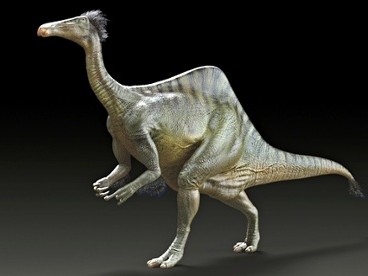by JAMES S. KIM
The fearsome Tyrannosaurus Rex had pretty much everything going for it — except for its itty bitty, poor excuses for arms that rendered its claws harmless. But when scientists in 1965 discovered the gigantic 8-foot-long arm, shoulder and claw fossils of a mysterious dinosaur, they thought there was a new killer to join the T-rex.
Deemed the Deinocheirus mirificus, the fossils were originally extraordinary enough for scientists at the time to declare the dinosaur a new genus and species. The name is quite literal, as it means “terrible hands that look peculiar.”
Fifty years later, scientists now have a completely different perspective on the animal. A Korean-led team of experts released a report on the dinosaur in the scientific journal Nature on Wednesday, reconstructing the creature in light of a recent discovery of two nearly complete 70-million-year-old dinosaur skeletons in Mongolia. Instead of being fearsome, scientists believe this dinosaur may have been more akin to a large ostrich-like Jar Jar Binks.
“Deinocheirus turned out to be one of the weirdest dinosaurs beyond our imagination,” study lead author Young-Nam Lee, director of the Geological Museum in Daejeon, South Korea, told the Associated Press.
With the new fossils, along with a skull and hand that had been poached and sold to private collectors, scientists built the first accurate representation of the dinosaur. The Deinocheirus apparently stood tall on its back legs, sporting long, clawed forearms and strong shoulders. One of the specimens found had grown to 11 meters long and weighed more than six tons, leading scientists to speculate that the species grew to that size to prevent being eaten by larger animals.
The dinosaur’s spine formed a hump-like sail on its back, and its duck-like bill (with no teeth) was geared to suck up soft vegetation or forage for food at the bottom of streams, including fish. It had broad hips and large feet to keep it from sinking on wet ground, suggesting it was not agile.
Add in a few feathers here and there, and all in all, the Deinocheirus wasn’t as much of a fearsome killer as it was an ostrich-like cow. With this new information, scientists now believe it belongs to a group of beaked omnivores called omithomimosaurs, an ancestral relative of the modern ostrich. A computer rendering of the dinosaur shows that it may have had the grace of the aforementioned Jar Jar Binks.
Even the scientists admitted they were surprised at how unusual the Deinocheirus turned out to be. “The discovery of the original specimen almost half a century ago suggested that this was an unusual dinosaur, but it did not prepare us for how distinctive the Deinocheirus is — a true cautionary tale in predicting body forms from partial skeletons.”
Images via Korea Institute of Geoscience and Mineral Resources








